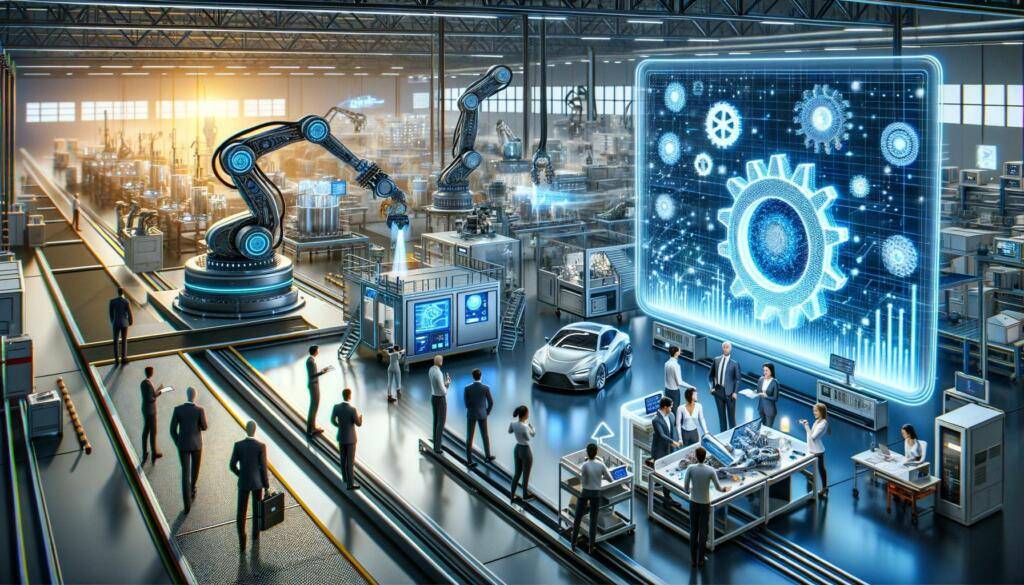The combination of Industry 4.0, artificial intelligence (AI), and 3D Printing creates the possibility of a step-change evolution in the industrial sector. This interconnected ecosystem is not just a convergence of technologies, but a necessary interdependence designed to meet modern manufacturing’s demands for customization, efficiency, and sustainability.
Let’s explore how these pillars rely on one another to create a resilient and innovative industrial framework.
Table of Contents
Fueling Innovation: From Data to Design to Production
The need for customization within mass production has driven the adoption of Industry 4.0, which connects manufacturing processes via digital technologies. However, the real change happens when this infrastructure is amplified by AI’s decision-making capabilities and the physical flexibility of 3D printing.
In aerospace, for instance, GE Aviation exemplifies this collaboration. AI analyzes performance data from aircraft engines, identifying inefficiencies and recommending design changes. Generative design tools powered by AI then create optimized components which are lighter, stronger, and more efficient. 3D Printing materializes these intricate designs, bypassing the limitations of traditional manufacturing. This iterative loop, data-driven insights, AI-generated optimization, and rapid prototyping showcases how the combination accelerates innovation.
A Seamless Network for Real-Time Responsiveness
Industry 4.0 thrives on connectivity, where sensors and systems share real-time data. But this data needs AI’s cognitive power for actionable insights and 3D printing’s agility to translate those insights into tangible outputs.
Take an automotive plant as an example. Smart sensors track machine performance and material usage across the production line, flagging inefficiencies or disruptions. AI predicts potential issues, such as an impending bottleneck or spike in demand for a specific part. Instead of waiting for traditional supply chain solutions, 3D printing steps in to produce the required parts on-demand. This integrated response ensures agility, minimizes downtime, and keeps operations running smoothly.
Building Sustainability Layer by Layer
Sustainability is becoming imperative. The partnership between Industry 4.0, AI, and 3D printing paves the way for more sustainable manufacturing practices.
AI optimizes energy consumption, identifying wasteful patterns and recommending corrective measures. Industry 4.0 enables these changes to be implemented across interconnected systems in real time. Meanwhile, 3D printing reduces material waste through its additive approach, layer by layer, using only what’s necessary.
ICON, a construction company, demonstrates this synergy by using 3D printing to build sustainable housing. AI refines designs to minimize material usage while maintaining structural integrity. The 3D printer executes these optimized designs with precision, employing eco-friendly materials like bio-concrete. This process not only cuts waste but also shortens construction timelines, making housing more accessible and sustainable.
Personalized Manufacturing for Today’s Consumer
Modern consumers demand products tailored to their unique preferences. The trio of Industry 4.0, AI, and 3D printing enables manufacturers to deliver personalized solutions at scale.
Adidas is a prime example. Using Industry 4.0’s real-time data collection from wearable sensors, the company gathers foot measurements and gait analyses. AI processes this data to create a conformal shoe design tailored to the individual’s biomechanics. 3D printing then produces the shoe’s midsole, integrating these personalized features seamlessly. This collaborative approach balances the efficiency of mass production with the bespoke appeal of custom manufacturing.
Data is Core to this Integration
At the core of this collaboration lies data generated by Industry 4.0 systems, interpreted by AI, and executed through 3D printing.
Predictive maintenance in manufacturing illustrates this interplay. Smart sensors monitor equipment for vibration, temperature, and wear. AI analyzes this data to forecast potential failures, enabling preemptive maintenance. If a replacement component is needed, 3D printing produces it on demand, reducing inventory costs and minimizing downtime. This continuous feedback loop turns raw data into actionable and efficient outcomes.
Redefining Design and Prototyping
The traditional cycle of design and prototyping is labor-intensive and time-consuming. By leveraging AI and 3D printing within an Industry 4.0 framework, manufacturers can achieve unprecedented efficiency.
Automotive companies like Tesla and Czinger showcase this advantage. AI-driven generative design tools explore innovative solutions, producing multiple design iterations based on parameters like weight and material efficiency. Once a design is chosen, 3D printing rapidly creates a prototype for testing. Real-time feedback from Industry 4.0 systems then refines the design further. This iterative process reduces time-to-market while enhancing product quality. The design can then be used further in the production process as well.
Elevating Quality Control
Maintaining stringent quality standards is core to modern manufacturing. The collaboration between Industry 4.0, AI, and 3D printing ensures unparalleled precision and consistency.
Pharmaceutical companies, for example, rely on real-time monitoring of production lines enabled by Industry 4.0. AI detects deviations from quality standards, flagging potential defects. Instead of halting production, 3D printing can create corrected components instantly, avoiding costly delays. This proactive approach improves efficiency, reduces waste, and upholds quality benchmarks.
A Unified Way Forward
The integration of Industry 4.0, AI, and 3D printing does go hand in hand to realize these benefits. It’s a transformative leap toward smarter, more sustainable, and more responsive manufacturing. Together, these technologies empower businesses to adapt to changing demands, deliver personalized solutions, and lead in a competitive global landscape and further refine business models.


